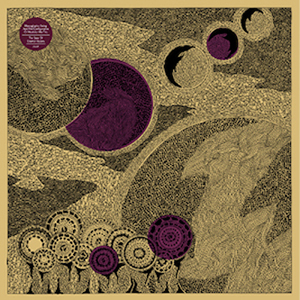Hieroglyphic Being and The Configurative or Modular Me Trio The Seer of Cosmic Visions
Chicago’s Jamal Moss, who operates as Hieroglyphic Being and under a host of other aliases, […]

Chicago’s Jamal Moss, who operates as Hieroglyphic Being and under a host of other aliases, has lately enjoyed a peak in popularity. For years, Moss worked in relative obscurity, turning out low-key releases while simultaneously weirding out a lot of people with his intense, and at that time high-pitched, sound (some of those gnarly pitches are easily evened out with a mixer, by the way). He incorporates a slightly slicker, more bass-heavy approach now, which is evidenced in places on The Seer of Cosmic Visions, a new compilation of his work (with “The Configurative or Modular Me Trio”) from UK label Planet Mu. Moss’ records aren’t especially tough to get ahold of, but there are a lot of them, so this attempt to organize the artist’s output is welcome.
The dates on these productions are pretty spread out—Discogs finds an iteration of “Space Is the Place” from 2005, while the wonderfully titled “How Wet Is Your Box” came out in 2012—but Moss’ abstract style (i.e. the signature that granted him this greatest hits collection in the first place) ensures cohesion. Both “Space Is the Place” and “How Wet Is Your Box” are highlights; a 10-minute version of the former appeared in 2009, so this one (clocking in at 8:42) is slightly abridged, but it retains all of its grace; it’s a serene, tiptoeing trip, laced with a fluid melody that’s only really comparable to someone like Jeff Mills. “How Wet Is Your Box,” meanwhile, stutters and chops like the best of Sound Stream, albeit in a grottier setting, informed by the Moss’ formative years at Ron Hardy’s Music Box in Chicago. Both also illustrate Hieroglyphic Being’s central balance between caustic, industrial thrust and heavenly, searching melody.
Beyond this, Moss’ work simply sounds alive. There’s no easier way to say it. The artist has always had a daring, improvisational streak, and these are among the finest efforts in his catalog. “A Genre Sonique,” from 2010’s Compositeurs Sans Frontières, is all tight, thunderous jazz drums, blasted and distorted, with foreboding pads drifting on top (reminding of Morphosis), and it commands attention for its spiralling, nine-minute duration. On “134340 Pluto,” he draws lines between cyclical African drumming, streaky coldwave synth motifs, and uptempo Chicago house, while the urgent push of “Calling Planet Earth” feels languid as his patterns shapeshift around one another.
It’s a cliché when describing any compilation of older material (and granted, some of these tracks are not very old) to say that the music holds up today, but The Seer Of Cosmic Visions absolutely does. Moss’ contributions are beyond vital. His list of influences is deep, and he has plenty of collaborations to his name, but his music is instantly identifiable and does exist, more or less, on its own plane. His recent rise in popularity isn’t as much a case of the world catching up to him as it is the world catching up to where he was a few years ago.

